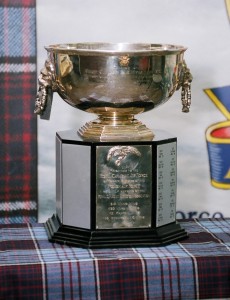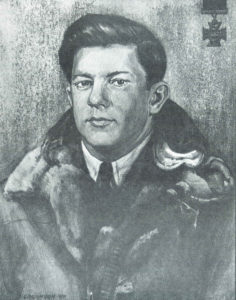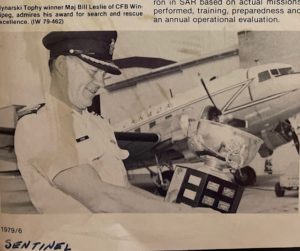
The Mynarski, VC Memorial Trophy presented to the Royal Canadian Air Force by former members of the Polish Air Force presently members of the Royal Canadian Air Force Association from 310 Wilno Wing, 430 Warsaw Wing, 431 Krakow Wing, and 436 Mynarksi, VC Wing “In Memory of Pilot Officer A.C. Mynarski, VC whose gallantry in the air and sacrifice will long remain an inspiration – ‘ I have fought a good fight. I have finished my course. I have kept faith. ‘ being the inscription on the Polish Air Force memorial Northold, England.

The Mynarski Trophy was presented for the first time at the 1958 Annual Convention held in Edmonton, Alberta. At the time it was introduced, the Mynarski Trophy was awarded to the Royal Canadian Air Force Wing (Station) offering up the most effective and successful social, recreational and cultural support program/facility/venue to Canadian Forces families and dependents lodging and working at the Wing/Station/Base. The Mynarski Trophy was subsequently re-purposed circa 1976. In 1976 the Mynarski Trophy was introduced as Canada’s highest award for excellence in the field of air search and rescue, and may be awarded “to the most deserving federal, provincial or civilian organization, crew or individual in recognition of a significant contribution to aviation search and rescue in Canada.” The trophy memorializes Pilot Officer Andrew Charles Mynarski of 419 “Moose” Squadron, who was posthumously awarded the Victoria Cross. Mynarski gave his life trying to free a trapped air gunner as their stricken Lancaster bomber plummeted in flames, 13 June, 1944 after being hit by enemy fire during a raid over enemy-occupied Europe. A more complete description of the exploits of Andy Mynarski follow.
The Mynarski, VC Memorial Trophy is awarded annually by the RCAF Association to the most deserving federal, provincial or civilian organization, crew or individual in recognition of a significant contribution to air search and rescue in Canada. Pilot Officer Mynarski was the mid-upper gunner of a 419 Squadron (RCAF) Lancaster aircraft, detailed to attack a target at Cambrai in France, on the night of 12th June 1944. The aircraft was attacked from below and astern by an enemy fighter and ultimately came down in flames. As an immediate result of the attack, both port engines failed. Fire broke out between the mid-upper turret and the rear turret, as well as in the p0rt wing. The flames soon became fierce and the captain ordered the crew to abandon the aircraft. Pilot Officer Mynarski left his turret and went towards the escape hatch. He then saw that the rear gunner was still in his turret and apparently unable to leave it. The turret was, in fact, immovable, since the hydraulic gear had been put out of action when the port engines failed, and the manual gear had been broken by the gunner in his attempts to escape. Without hesitation, Pilot Officer Mynarski made his way through the flames in an endeavour to reach the rear turret and release the gunner. Whilst so doing, his parachute and his clothing, up to the waist, were set on fire. All his efforts to move the turret and free the gunner were in vain. Eventually the rear gunner clearly indicated to him that there was nothing more he could do and that he should try to save his own Iife. Pilot Officer Mynarski reluctantly went back through the flames to the escape hatch. There, as a last gesture to the trapped gunner, he turned towards him, stood to attention in his flaming clothing and saluted, before he jumped out of the aircraft. Pilot Officer Mynarski’s descent was seen by French people on the ground. Both his parachute and his clothing were on fire. He was found eventually by the French, but was so severely burned that he died from his injuries. The rear gunner had a miraculous escape when the aircraft crashed. He subsequently testified that, had Pilot Officer Mynarski not attempted to save his comrade’s life, he could have left the aircraft in safety and would, doubtless, have escaped death. Pilot Officer Mynarski must have been fully aware that in trying to free the rear gunner he was almost certain to lose his own life. Despite this, with outstanding courage and complete disregard for his own safety, he went to the rescue. Willingly accepting the danger, Pilot Officer Mynarski lost his life by a most conspicuous act of heroism which called for valour of the highest order.
General
21.01 The NEC in 1976 approved the establishment of the Mynarski Trophy as an award to be presented to the most deserving unit, individual(s) or organization, in recognition of a significant contribution to air Search and Rescue (SAR) in Canada.
Purpose
21.02 The Mynarski Trophy is awarded annually by the Air Force Association of Canada to the most deserving federal, provincial or civilian organization, crew or individual, “IN RECOGNITION OF OR CONTRIBUTION TO AVIATION SEARCH AND RESCUE IN CANADA”
Eligibility
21.03 Any citizen, group or unit/organization engaged in military or civilian air SAR is eligible to be considered for the trophy.
Recommendations and Submissions
21.04 The recommendation for potential military candidates shall be passed to the Secretary of the National Honours & Awards Committee on or before the first day of July each year. As applicable, submissions are to be staffed through the NDHQ/CAS Office, via 1 Canadian Air Division HQ, to NHQ, Ottawa. Nominations for potential candidates from civilian organizations should be submitted to the Secretary of the National Honours & Awards Committee by the same date.
Selection Criteria
21.05 The criteria for nominations are:
a) effectiveness in SAR operations, considering the intensity of activity and the established resources;
b) heroic performance of a crew or an individual during a single incident;
c) a very special or outstanding contribution to SAR during the period by an individual, and,
d) outstanding performance by an organization or individual in promoting Flight Safety and SAR training in the civilian sector.
Power to Amend Selection Criteria
21.06 The NEC shall retain sole authority over the development and amendment of selection criteria and shall be the sole arbiter of disputes regarding their application or implementation.
National Honours & Awards Committee Membership
21.07 The Committee shall be:
a) Honorary National President, Chairman;
b) All Group Presidents;
c) Immediate Past President; and
d) Executive Director (ex-officio Member and Committee Secretary)
21.08 In no case, may a person nominated for the trophy be permitted to be a member of the committee during the year in which he or she is nominated.
Award Presentation Frequency
21.09 The trophy will be presented annually. The period of assessment is the preceding calendar year.
Retention of Trophy
21.10 Each recipient shall be entitled to hold the trophy until recalled and shall be provided with a suitable keeper plaque at the time the trophy is presented.
Presentation
21.11 Presentation of the trophy will be made at an Annual General Meeting of the Association or, a special function will be arranged.
Initial Cost and Maintenance
21.12 The cost of the keeper plaque and of trophy maintenance will be borne by NHQ.
(21.13 to 22.00, inclusive, not allocated)
Winners
RCAF Parent – 1958-59
RCAF Cold Lake – 1959-60
RCAF Gimli – 1960-61
RCAF Cold Lake – 1961-62
RCAF Comox – 1962-63
RCAF Comox – 1963-64
RCAF La Magaza – 1964-65
CFB St Hubert – 1965-66
CFB Cold Lake – 1966-67
CFB Greenwood – 1967-68
CFB Gypsumville – 1968-69
CFB Uplands – 1969-70
CFB Cornwallis – 1971-72
CFB Yorkton – 1972-73
CFB Ottawa (S) – 1973-74
442 (T&R) Squadron – 1978
Major W.G. Leslie, CD Air Command Headquarters – 1979
413 (T&R) Squadron CFB Summerside PEI – 1980
442 (T&R) Squadron Comox BC – 1981
413 (T&R) Squadron CFB Summerside PEI – 1982
442 (T&R) Squadron Comox BC – 1983
103 Rescue Unit Gander NFLD – 1984
RCC Victoria – 1985
Base Rescue Flight CFB Bagotville – 1986
Canadian Mission Control Centre – 1987
Rescue Crew 318, Rescue Crew 459 of 413 (T&R) Sqn – 1988
Rescue (302) and Rescue (457) – 1989
429 Transport Squadron – 1990
Civil Air Search & Rescue Assn – 1991
408 Tac Hell (sic) Sqn – 1992
Crew 311 442 Sqn – 1993
424 (T&R) Sqn, Astra, ON – 1994
435 (T&R) Sqn Winnipeg, MB – 1995
443 (MH) Sqn Esquimalt, BC – 1996
413 (T&R) Sqn Greenwood, NS – 1997
442 (T&R) Sqn – 1998
12 Wing Shearwater – 1999
442 (T&R) Sqn 19 Wing Comox – 2000
423 (Maritime Helicopter) Squadron – 2001
442 (T&R) Sqn 19 Wing – 2002
444 (CS) Sqn 5 Wing, Goose Bay – 2003
442 (T&R) Sqn 19 Wing, Comox – 2004
103 (SAR) Sqn 9 Wing Gander, NF – 2005
413 (T&R) Sqn 14 Wing Greenwood, NS – 2006
435 (T&R) Squadron 17 Wing Winnipeg – 2007
103 (Search & Rescue) 9 Wing Gander – 2008
424 Sqn, 413 Sqn, 439 Sqn & JRCC Trenton – 2009
Alberta STARS Association – 2010
Search & Rescue 424 Squadron, 413 Squadron, 439 Squadron – 2011
RCAF S.A.R. Griffon Community OP JAGUAR – 2012
109 (Search & Rescue) Squadron – 2013
422 (Transport & Rescue) Squadron – 2014
- 423 (Maritime Helicopter) Squadron – 2001
- 424 Sqn – 413 Sqn – 439 Sqn – JRCC Trenton
- Major W.G. Leslie
- 413 (T&R) Squadron CFB Summerside PEI – 1982
423 (Maritime Helicopter) Squadron, 12 Wing, Shearwater, in recognition of outstanding performance and professionalism under difficult flight conditions by the Sea King helicopter crews of 423 Sqn detachments aboard HMCS Halifax, Preserver and Iroquois, while conducting search and rescue operations on bulk carrier MV Leader “L”, enroute Spain to New York, on 23-24 March 2000. .Enroute to the Caribbean for Operation Readiness Operations, 23 March, the Canadian Atlantic Task Group responded to a distress call from the 31
crew complement of Leader that it was about to sink.. Sea King equipped ships diverted to the ship’s location, and when within 100nm, launched 2 helicopters in night visibility and severe weather conditions. Arrival on scene confirmed the ship had sunk and crew were in the sea and in life rafts deployed by 413 Sqn Hercules from Greenwood earlier. Complicated lowering conditions by rescue crewmen, in 30 knot winds, was carried out until minimum fuel condition was reached. 12 of the ship’s crew were rescued, followed by a 13th on the second sortie, all subsequently off loaded in Bermuda by HMCS Iroquois for medical care. This operation is another
example of the resolve and bravery of Canadian Forces rescue crewmembers, that we hear of so often, when faced with unexpected emergency situations. 423 Sqn is highly deserving of the award of the Mynarski Trophy, 2001.
With the true spirit of teamwork and cooperation, two lives were saved in a terrible plane crash in northern Quebec where four other lives were lost. In a joint effort involving four units; JRCC Trenton, 424, 439 and 413 Squadrons, the mission to rescue the two survivors in the harsh, austere, wooded environment 100 miles north of Bagotville was accomplished in a most professional and expeditious manner. The initial call came to JRCC Trenton on 16 July, 2010 at about 3:00 pm for an overdue DeHavilland DHC-2 Beaver with six persons on board. The aircraft had radioed that it was landing due to bad weather, but it was not heard from when the weather improved. The 424 Sqn CC130 Hercules and CH146 Griffon were initially tasked, and with the Hercules only 30 minutes from the search area, the crashed Beaver was spotted by another aircraft. A survivor was seen waving from the broken fuselage.The Hercules crew hastily prepared for a live parachute insertion of two SAR Techs, while JRCC requested further assistance from 439 and 413 Sqns as the crash was now confirmed with possibly 6 survivors, too many for the single Griffon from 424 Sqn to handle. At around 6:00 pm the two 424 Sqn SAR Techs parachuted into a rough landing zone 800 metres from the crash site with 20 knot winds. After a safe landing they made their way to the crash site where they could hear someone banging on the fuselage, and on arrival they were met by a 15 year old boy who appeared unhurt, but in shock. He led them to another survivor, his 59 year old uncle, who had severe burns, but was conscious. Confirming that the other four persons had perished in the crash, one of which was the boy’s father, the SAR Techs called for the helicopter extraction and set to work stabilizing the two patients, and preparing them for transport.By this time a Griffon from Bagotville was able to put together a crew and were expected to arrive at the crash site by 8:00 pm, with the Cormorant on scene about an hour later and the 424 Sqn Griffon two hours later. With enough helicopter assets capable of rescue, JRCC recalled the 424 Sqn CH146. The 439 Sqn Griffon arrived on scene and hoisted their two SAR Techs into the crash site to assist. After about one hour they extracted the two survivors and delivered the patients to a hospital in Chicoutimi but the helicopter did not have enough room for the 424 Sqn SAR Techs and their equipment. The Cormorant was tasked to recover the remaining SAR Techs and the deceased, along with the extra equipment and return them to Bagotville. Due to the severe conditions of the burn victim the 439 Sqn Griffon was subsequently tasked at around midnight to MEDEVAC him to the Burn Unit in Quebec City.All the crews completed long crew days to accomplish the mission, with the C130 crew having worked a full 18 hours. The dedication, commitment, and resourcefulness of the crews were exemplary. 439 Sqn had to piece together a crew from members on leave, and the Cormorant crew was assisting in a mission outside of their normal SAR Region. The fact that JRCC can call upon three different units who can work so easily together to accomplish one mission is a testament to the high level of training, proficiency and flexibility within all units of the National SAR System. This mission is a testament to the outstanding quality of the men and women that make up our SAR units, all extremely devoted to saving human life, reflecting the SAR Tech motto, “That Other’s May Live.”
 The Mynarski Trophy, awarded for contributions to search and rescue (SAR), has gone to an individual this year. Major Bill Leslie, senior staff officer for air transport at Air Command Headquarters Winnipeg, was selected by the RCAF Association.
The Mynarski Trophy, awarded for contributions to search and rescue (SAR), has gone to an individual this year. Major Bill Leslie, senior staff officer for air transport at Air Command Headquarters Winnipeg, was selected by the RCAF Association.
Major Leslie joined the Forces in 1952 and has worked in SAR since 1964. His outstanding efforts in that capacity have made him well known in Canadian SAR circles. In 1976 he participated in a major government study of SAR resources. He also sat on the inter-departmental SAR committee on organization and control of government SAR resources. Over the years, he has assisted in the improvement of Canadian Forces helicopters and helped develop the SAR technicians’ trade.
The trophy was created by former members of the Polish Air Force who now belong to the RCAF Association, to honour the memory of Pilot Officer Andy Mynarski. He was awarded the Victoria Cross for attempting to rescue a trapped tail gunner in his crippled and burning bomber over France in 1944. The tail gunner lived to tell of Mynarski’s sacrifice, but Pilot Officer Mynarski died as a result of his burns. He was awarded the VC posthumously.
Since 1976 the trophy has been awarded to the most deserving squadron in SAR based on actual missions performed, training, preparedness and an annual operational evaluation
From The Daily Gleaner (Fredericton, New Brunswick) Saturday, October 9, 1982
QUOTE Colonel Denny Hopping of 413 Squadron, Summerside, PEI has accepted the Mynarski Trophy awarded annually to the best search and rescue team. The presentation was made at the annual general meeting of the Royal Canadian Air Force Association. The trophy was presented by Colonel Arnie J. Bauer.
The 413 Squadron was involved in 370 SAR operations during the year. Six of the missions were major rescue operations that resulted in the saving of 79 lives. Most were conducted in poor weather and under difficult circumstances. The squadron, for example, co-operated in the rescue of 26 people from the grounded Euro Princess in a severe Atlantic storm off Sable Island.
Selection of the Mynarski Trophy winner was made by Air Command Headquarters at CFB Winnipeg. The trophy, donated by the RCAF Association is named for a Commonwealth pilot who lost his own life while he saved rear gunner in his aircraft. UNQUOTE
[RCAF Association comments: contrary to the closing words above, Pilot Officer Mynarski DID NOT save the rear gunner (Pat Brophy) at all. Mynarski was unsuccessful in a number of attempts to free Brophy in his jammed tail-gunner turret. Brophy demanded Mynarski stop his futile attempts and save himself. Conceding to Brophy’s demands, Mynarski backed off, stood as erect as possible, saluted Brophy, and jumped. Unfortunately, while attempting to free Brophy, Mynarski’s clothing had just caught fire, which began consuming his blossomed parachute in the descent. Mynarski survived the jump but died not long after from his burns. Miraculously, Brophy and his tail-gunner turret broke free from the unpiloted aircraft on crashing, and Brophy survived to tell the story of Mynarski and his valiant but futile attempts to save him.]








